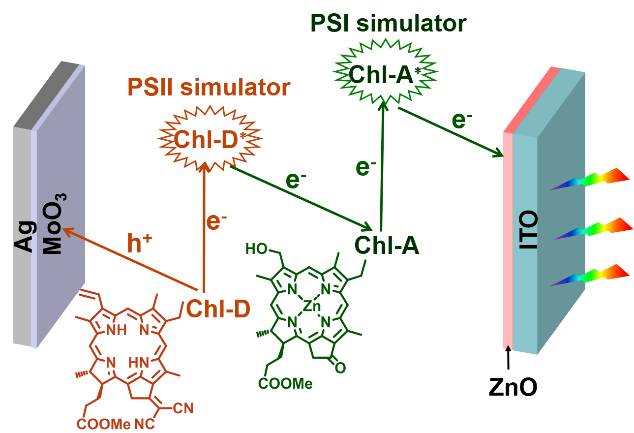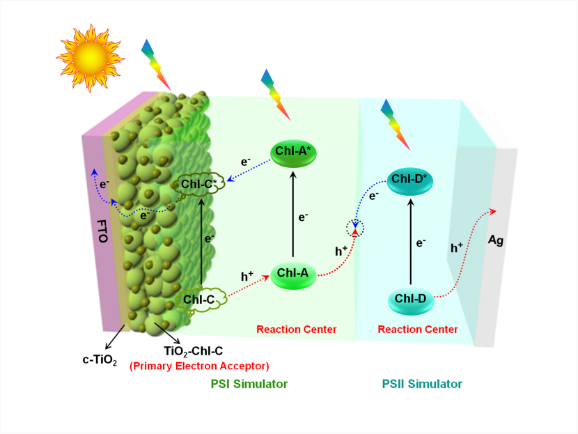The natural photosynthetic organisms on the earth have evolved over a billion years to form a matured transformation system from light energy to chemical energy.The core of this photosynthetic system is a pigment-protein complex based on chlorophyll molecules that function from light energy capture to energy transfer and ultimately to charge separation. Chlorophylls are the most environment-friendly organic and functional semiconductor with abundant storage in the nature world. If chlorophylls and their derivatives could be used as the major photoactive materials to fabricate the new type of solar cells, it would realize the effective usage of cheap renewable natural resources, but also likely to achieve potentially high power conversion efficiency by mimicking the light-to-energy conversion processes in natural systems. Such kind of low-cost and environment-friendly solar cells are potential to be the next generation of photovoltaic to solve the energy and environment problems of our country and provide the foundations for the sustainable development of our country
Prof. Xiao-Feng Wang’s group dedicates to the development of applying the chlorophylls and their derivatives as main light-sensitive materials to the dye-sensitized solar cells, organic solar cells, perovskite solar cells. Moreover, inspired by the natural photosynthetic system, the group simulates the electron transfer pathway of natural Z-scheme process of oxygenic photosynthesis and fabricates two types of bilayer and trilayer bio-solar cells, which employ chlorophyll derivative as the only light-sensitive material. The results bring a new perspective for the further development of bio-solar cells.
Shengnan Duan, a doctoral candidate enrolled in 2018, is the first researcher in the world who employs chlorophyll derivative to simulate the electron transfer pathway of the natural Z-scheme process of oxygenic photosynthesis, and fabricates the bilayer bio-solar cells by employing chlorophyll derivatives. The photoactive upper layer is the ambipolar dicyano functionalized chlorophylladerivative to simulate the photosystem II (electron donor). Meanwhile, the bottom layer employs the zinc hydroxymethylated chlorophyllaaggregate to simulate photosystem I (electron acceptor). A power conversion efficiency of 1.30% was reached under standard AM1.5 illumination. This research provides a new idea for the device design and relavent results have been published in ACS Energy Letters (DOI: 10.1021/acsenergylett.8b02279).

Graph 1. The bilayer bio-solar cell that simulates the Z-scheme process of oxygenic photosynthesis.
Based on the abovementioned research result, Wenjie Zhao, a doctoral candidate enrolled in 2016, optimizes the structure of the solar cell. A kind of carboxylated chlorophyllaadsorbed into the mesoporous TiO2mimics the initial electron acceptor instead of previous zinc oxide. While the other photoactive layers keep the same: the upper layer is the ambipolar dicyano functionalized chlorophylladerivative to simulate the photosystem II (electron donor) and the middle layer employs the zinc hydroxymethylated chlorophyllaaggregate to simulate light system I (electron acceptor). Benefitting from a better light-absorption, charge extraction and transfer due to the combine of the multipigment synergy, the trilayer bio-solar cell achieves a power conversion efficiency as high as 4.2%. The relevant research result has been published in ACS Energy Letters (DOI: 10.1021/acsenergylett.8b02279).

Graph 2. The tripayer bio-solar cell that simulates the Z-scheme process of oxygenic photosynthesis.
In addition, Prof. Xiaofeng Wang’s group also focuses on applying chlorophyll derivatives in dye sensitized solar cell, organic solar cell, perovskite solar cell, photocatalytic hydrogen evolution, super capacitor storage and so on, and has made a series of important progress. Relevant research results have been published in world-class journals including Materials Chemistry Frontiers(DOI:10.1039/c9qm00377k), Solar RRL (DOI:10.1002/solr.201900203; DOI:10.1002/solr.202000166; DOI:10.1002/solr.202000162), ACS Applied Energy Materials(DOI:10.1021/acsaem.8b00380), Advanced Materials Interface(DOI: 10.1002/admi.201902080), and Electrochimica Acta(DOI: 10.1016/j.electacta.2020.136283) etc. Meanwhile, Prof. Xiao-Feng Wang’s group is engaged in the study of MXenes, a 2D layered material, in photovoltics and photocatalysis. Relevant results have been published by authoritative academic journals, including Advanced Functional Materials(DOI: 10.1002/adfm.201905694), Nano-Micro Letters(DOI: 10.1007/s40820-019-0309-6), Journal of Materials Chemistry A(DOI: 10.1039/c8ta12140k; 10.1039/C8TA02706D).